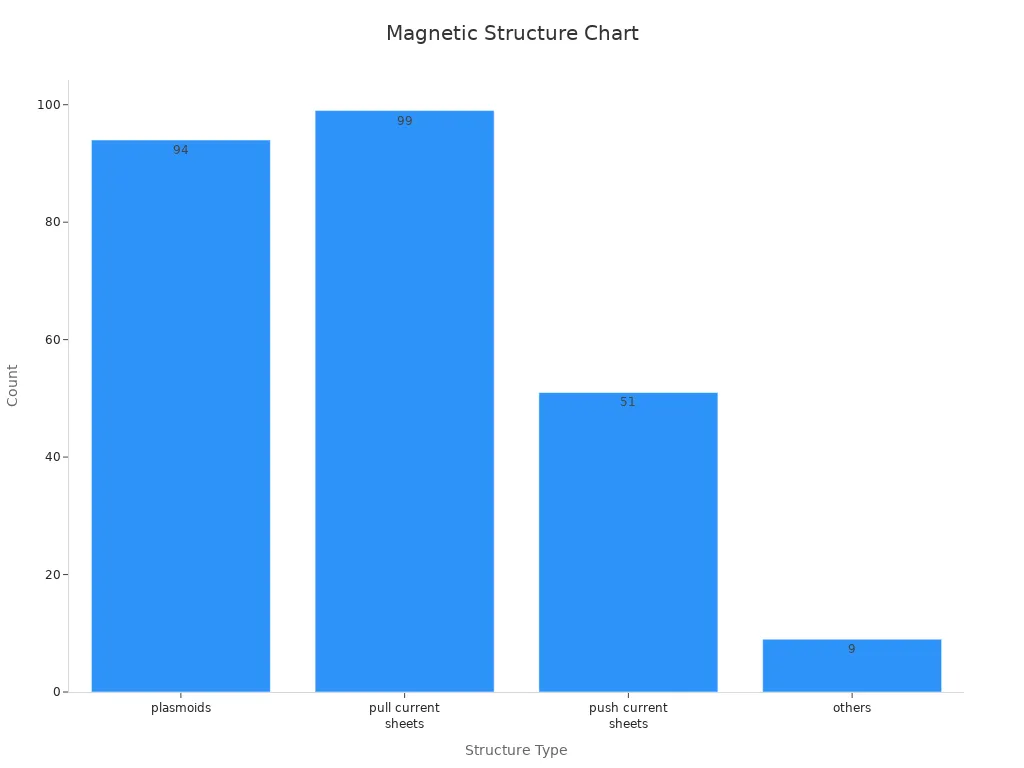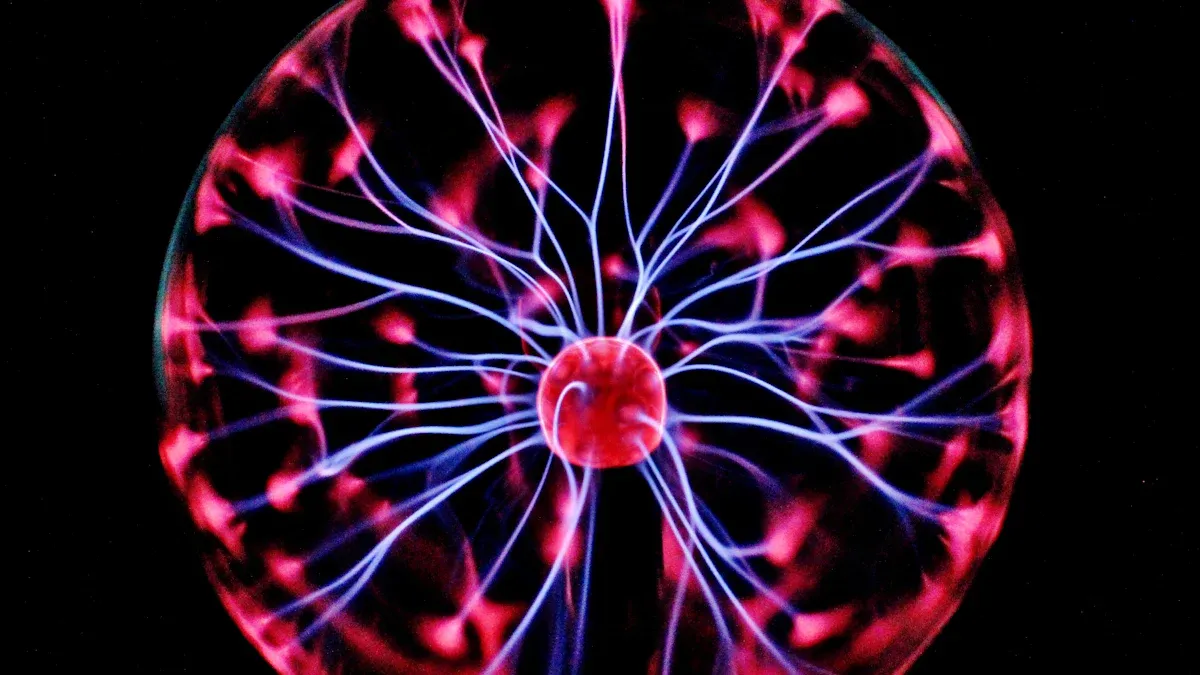A magnetic field is the invisible space around a magnet or electric current. In this space, magnetic forces can push or pull things. It can move objects like iron filings or compass needles. For example, a refrigerator magnet makes a field that can hold up a note. Earth’s magnetic field helps compasses point north. The strength of a magnetic field can be very different. You can see this in the table below:
| Example | Typical Strength |
|---|---|
| Refrigerator Magnet | ~0.001 Tesla (10 G) |
| Neodymium Magnet | ~1.4 Tesla (14,000 G) |
| Earth’s Surface Field | Nanotesla range |
Key Takeaways
- A magnetic field is an invisible area around magnets or electric currents. It can push or pull things like iron or compass needles.
- Magnetic fields always make closed loops. They have direction and strength. Scientists use arrows and field lines to show this.
- Moving electric charges and electric currents make magnetic fields. These fields are important in nature and technology. Lightning and electric motors use them.
- Earth’s magnetic field keeps us safe from harmful space radiation. It also helps compasses point north so we can find our way.
- Magnetic fields are important in daily life and technology. We see them in refrigerator magnets, credit cards, MRI machines, and magnetic trains.
Magnetic Field Basics
Definition
A magnetic field is the space near a magnet or electric current where magnetic forces work. You cannot see this field, but scientists can measure its effects. The magnetic field can push or pull things like iron or steel. It also changes how moving electric charges behave. Scientists use “tesla” to measure how strong a magnetic field is.
A magnetic field is real and not just an idea.
- Hans Christian Øersted proved electric currents make magnetic fields. He saw a compass needle move near a wire with current.
- Magnetic fields create forces that act at right angles to both movement and the field.
- A compass needle points along Earth’s magnetic field, showing its direction.
- Magnetic poles can attract or push away from each other. This depends on if they are the same or different.
- Scientists have seen magnetic field lines form loops around wires and coils. This matches what theory says.
- The strength of a magnetic field can be measured, so it is a real thing.
Properties
Magnetic fields have some key properties. They always make closed loops, so the lines never start or end in empty space. The field goes from the north pole to the south pole outside a magnet. Inside the magnet, the field goes from south to north, making a loop. Magnetic fields can change how strong they are and which way they point, depending on what causes them and where they are.
Scientists have studied many magnetic structures in labs. The table below shows some common results from these studies:
| Statistical Result Aspect | Details |
|---|---|
| Number of Magnetic Structures Observed | 288 total structures: 94 plasmoids, 99 pull current sheets, 51 push current sheets, others uncategorized (~3%) |
| Size Distribution | Plasmoids and pull current sheets sizes mostly <10 electron inertial lengths (d_e) |
| Statistical Model Fit | Size distributions fit exponential distribution; power law rejected by Kolmogorov-Smirnov tests |
| Statistical Method | Maximum Likelihood Estimation (MLE) used for fitting size data, avoiding binning bias |
| Confirmation of Theory | First in situ confirmation of Fermo et al. (2010) prediction of exponential size distribution |
| Nature of Plasmoids | Many plasmoids do not fit classical cylindrical flux rope models, showing they are dynamic and not simple in turbulent reconnection |
| Detection Methods | Automated detection was made for nonideal plasmoids and current sheets, making results more reliable |
| Limitations | Multispacecraft techniques have limits because of how far apart the spacecraft are and because they assume things do not change over time |

Vector Field
A magnetic field is a kind of vector field. This means it has a direction and a strength at every spot in space. Scientists use arrows to show which way the field goes and how strong it is. The arrows point from the north pole to the south pole outside a magnet. The length of the arrow shows how strong the field is there.
Computer studies help scientists learn how magnetic fields work as vector fields. The table below shows how researchers use computer models to study how magnetic fields affect fluids and gases:
| Aspect | Description | Supporting Details |
|---|---|---|
| Simulation Type | Two-dimensional compressible magnetohydrodynamics (MHD) simulations | Used FLASH code to model Rayleigh-Taylor instability (RTI) and Kelvin-Helmholtz instability (KHI) under magnetic fields |
| Vector Field Evidence | Vector distributions of magnetic pressure gradient forces and thermal pressure gradient forces | Figures show magnetic pressure gradient forces as vectors at RTI spike tips, showing magnetic field direction and strength |
| Magnetic Field Effects | External magnetic field parallel to disturbance wave vector stops KHI vortices and makes RTI interface more stable | KHI vortex height is 40% lower at 5 T magnetic field than with no field; RTI growth rates change as vector field theory says |
| Lorentz and Magnetic Pressure Gradient Forces | Main forces that change RTI and KHI | Vector distributions show these forces act in certain directions, matching what we expect from a vector field |
| Quantitative Growth Rates | Linear growth rates of RTI and KHI found with and without magnetic field | Growth rate formulas use magnetic field vector parts; magnetic field changes growth rates as vector field theory predicts |
| Vorticity and Fluid Interaction | Vorticity patterns show magnetic field working with fluid flow | Magnetic field lines squeeze and bend with fluid at spike edges, stopping vortex formation, proving the field acts with direction |
| Density Ratio Variation | Effects checked at different Atwood numbers (density ratios) | Magnetic pressure gradient force size and direction change with density ratio, showing vector field behavior depends on physical details |
| Summary | Computer results prove magnetic field acts as a vector field and changes fluid instabilities | Vector force patterns, stopping of instabilities, and changes in growth rates all show magnetic field is a vector field in physics |
Scientists compare simple and complex models of magnetic fields to see which fits real data better. For example, in solar studies, a model with more twisted magnetic lines matched real field strengths better than a simple model. This means advanced models can show how magnetic fields really act in nature.
Magnetic Field Creation
Moving Charges
A moving electric charge always makes a magnetic field. When an electron moves, it creates a force. This force can change other charges nearby. This happens in nature and in machines. For example, lightning has fast-moving charges in the air. This makes a strong magnetic field. Scientists use this idea to explain how magnets work. It also explains why electric motors spin.
Electric Currents
Electric currents are moving charges, usually electrons, in a wire. When current flows, it makes a magnetic field around the wire. The field gets stronger if the current is stronger. The field gets weaker as you move away from the wire. Electric fields exist because of voltage. Magnetic fields only show up when current flows. Magnetic fields can go through buildings and even people. Electric fields are blocked more easily. Some studies show people near power lines may have more health risks. For example, children living within 40 meters of power lines have a higher risk of leukemia. Their risk is 1.5 to 3 times higher than for kids living farther away.
| Evidence Type | Description | Statistical Findings / Physical Principles |
|---|---|---|
| Epidemiological Studies | Studies link living near power lines with more childhood leukemia. | Children living close to power lines have 1.5 to 3 times higher leukemia rates than those farther away. |
| Early Studies | A 1979 Denver study found children with leukemia were more likely to live near power lines. | Wire codes showed exposure, but homes were not tested for magnetic fields. |
| Physical Principles | Magnetic fields come from electric current. The field gets weaker as you move farther away. | Example: 17 mG at the power line, 8 mG at 10 meters, less than 4 mG at 20 meters. Home appliances can make up to 1 mG nearby. |
Atomic Structure
Atoms help make magnetic fields too. Each atom has electrons that spin and move around the center. This movement makes tiny magnetic fields. When many atoms line up their spins, the material becomes magnetic. Scientists measure these effects using electron spin resonance. For example, single atoms of dysprosium show how electron spins make magnetic fields. Laser spectroscopy helps show how atomic structure changes the field’s strength and direction. In soil, very small ferrimagnetic particles can make up most of the magnetization. Even tiny particles can have a big effect. Paramagnetism and diamagnetism also depend on atomic structure. Paramagnetic materials have unpaired electrons that line up with a magnetic field. Diamagnetic materials make a weak field in the opposite direction.
Earth’s Magnetic Field

Geomagnetic Field
Earth works like a huge magnet. Its geomagnetic field wraps around the planet and goes far into space. The field is not the same everywhere. Some places, like the South Atlantic Anomaly, have less than 20 microTesla (µT) of field strength. In ten years, this area lost 3.5% of its strength. Other places, such as the Indian Ocean and Europe, got stronger fields. All over the world, Earth’s dipole field is getting weaker by about 6.3% every hundred years. Satellites, like ESA’s Swarm, found the biggest changes near the poles. Scientists use these measurements to watch how the field moves and changes. They also look at rocks and use math tests to study changes over millions of years. By looking at data from many places, they can see big patterns and compare field strength around the world.
Dynamo Effect
Earth’s geomagnetic field comes from deep inside the planet. The outer core is made of liquid iron and nickel. This part moves as Earth spins. The movement makes electric currents. These currents create the magnetic field through the dynamo effect. Scientists use math to show how this happens. They use things like density, spin speed, and how well the core carries electricity. They estimate the core’s field is about 2.7×10⁻⁴ Tesla. At Earth’s surface, it drops to about 2.5×10⁻⁵ Tesla. This matches what scientists measure at the equator. Computer models show that moving liquid in the core can make a strong, steady field. These models also show the field can flip direction, just like rocks show in Earth’s past.
Protective Role
Earth’s magnetic field is very important for life. It makes a shield called the magnetosphere. This shield blocks most dangerous solar and space radiation. Satellites like Swarm, Ørsted, and CHAMP watch how the field changes during solar storms. They show the magnetosphere gets squeezed on the Sun side and stretched on the night side. Weak spots, like the South Atlantic Anomaly, let more radiation reach Earth. Rocks show Earth’s field is now close to its strongest in 100,000 years. In 2008, scientists measured Earth and Mars during a special planet lineup. They found Mars lost oxygen from its air ten times faster than Earth in the same solar wind. This shows Earth’s magnetic field helps keep our air safe and lets life survive.
Visualizing Magnetic Fields
Field Lines
Scientists draw field lines to show what a magnetic field looks like. These lines help us see where the field goes and how strong it is. Field lines begin at the north pole and end at the south pole of a magnet. When lines are close together, the field is stronger there. If you put iron filings around a bar magnet, the filings line up with the field lines. This lets us see the pattern that is usually hidden. A compass needle points along the field lines, showing their direction. The right hand rule helps students remember which way the field goes around a wire. If you point your thumb with the current, your fingers curl the same way as the field lines.
Field lines never cross each other. Each spot in space has only one field direction.
Scientists can add field lines from different magnets using superposition. This means they combine the effects to find the total field. Field lines give a good idea of the field, but scientists use math to measure it exactly.
Direction and Strength
The direction of a magnetic field shows where a north pole would move. The strength tells how strong the field is at each place. In pictures, arrows show both direction and strength. Longer arrows mean the field is stronger. Scientists use computer models to draw these pictures. For example, computers use small grids to show big changes near coils and bigger grids farther away. These models match real tests, especially for the main field direction.
Researchers use computer models to study tricky magnetic fields, like those on the Sun. These models make 3D pictures that show how the field changes in space. In medicine, scientists use sensors and computers to map and control magnetic fields. This makes experiments more exact. These tools help people learn about and use magnetic fields in science and technology.
Importance of Magnetic Fields
Everyday Life
People use magnetic fields all the time, often without knowing it. Refrigerator magnets keep notes and photos on the fridge. Credit cards and hotel keys have tiny magnets to store information. Hard drives in computers use magnets to save and read data. Many home devices, like speakers and electric toothbrushes, need magnets to work. Some trains in cities float above tracks with magnetic levitation. This makes the ride faster and quieter because there is less friction.
| Sector/Use Case | Example/Measurement | Practical Application |
|---|---|---|
| Data Storage | Magnets on hard drives and credit cards | Stores digital information securely |
| Transportation | Train levitation via magnetic fields | Enables faster and safer travel |
| Measurement Tools | Hall-Effect meters measure in gauss/tesla | Accurate magnetic field measurement in daily settings |
Technology
Modern technology uses magnetic fields in many ways. MRI machines have strong magnets to make pictures inside the body. Doctors use these pictures to find injuries or sickness without surgery. MRI machines use superconducting magnets that can reach up to 45 teslas. This makes the scans clear and safe. Magnetic therapies, like Transcranial Magnetic Stimulation, send pulses to the brain to help treat depression. Engineers use magnetic nanoparticles to carry medicine right to sick parts of the body. This helps lower side effects. In factories, electromagnets lift heavy metal things and help sort materials.
- MRI machines use strong magnets to take pictures inside the body.
- Magnetic therapies help treat brain problems.
- Magnetically guided drug delivery sends medicine to the right spot.
- Electromagnets lift and sort things in factories.
Science and Nature
Scientists use magnetic fields to learn about Earth, space, and living things. Earth’s magnetic field protects people and animals from harmful solar radiation. This shield keeps dangerous particles from reaching us, making life possible. Researchers use magnetic fields to study how materials act at the atomic level. For example, they use equations like the Lorentz force law to see how charged particles move:
Some studies show that changes in Earth’s magnetic field might affect how people act. This shows magnetic fields are important for life and society.
Magnetic fields change our world in many ways. They help animals find their way when they travel. MRI machines use magnetic fields to make pictures of our bodies. Scientists learned that how strong a field is and how long it lasts can change living things, as shown below:
| Field Strength | Exposure Time | Observed Effect |
|---|---|---|
| 1.5 Tesla | 6 hours | More embryo problems happened |
| 0.2 mT | 7 days | Rat fertility stayed the same |
| 5 mT | 5 days | Fruit flies had fewer babies |
Magnetic fields are part of technology, health, and nature. People can see their effects in simple things like compasses or in hospital machines.
FAQ
What does a magnetic field do?
A magnetic field pushes or pulls on objects that have magnetic properties. It can move things like iron filings or make a compass needle point north. Magnetic fields help guide animals and protect Earth from harmful space radiation.
How can someone see a magnetic field?
People cannot see magnetic fields directly. They can use iron filings to show the pattern around a magnet. The filings line up along the field lines. A compass also shows the direction of a magnetic field.
Can magnetic fields harm people?
Most everyday magnetic fields are safe. Strong fields, like those in MRI machines, need special safety rules. Some studies suggest possible health risks near strong power lines, but scientists continue to study these effects.
Why do compasses always point north?
A compass needle lines up with Earth’s magnetic field. The needle’s north end points toward the magnetic north pole. This helps people find direction when they travel or explore.
Do all materials react to magnetic fields?
Not all materials react to magnetic fields. Iron, nickel, and cobalt show strong reactions. Most other materials, like wood or plastic, do not respond. Some materials, like copper, show weak effects that are hard to see.

